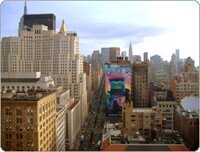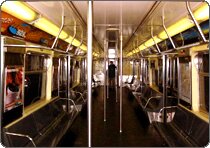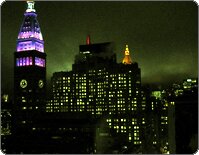City Guide
Introduction
 Hollywood has made New Yorkers of us all, not just those of us who live here. Thanks to the many movies that have been made here, even if you've never visited the city, you're probably already familiar with many of its famous sites. Over the course of any given day, you are likely to hear the phrase, "Oh, I recognize this! This is where so-and-so was in so-and-so movie," coming from the mouths of tourists.
Hollywood has made New Yorkers of us all, not just those of us who live here. Thanks to the many movies that have been made here, even if you've never visited the city, you're probably already familiar with many of its famous sites. Over the course of any given day, you are likely to hear the phrase, "Oh, I recognize this! This is where so-and-so was in so-and-so movie," coming from the mouths of tourists.
The real city is a bit different from the one you see in the movies and on television of course. Sex & the City, for example, inspired young women to flock to Manhattan, to find that the only places they could afford to live were in studio apartments in the outer-boroughs, and between work and commuting, they were experiencing plenty of the city, but not as much sex as the characters in the show, all of whom seemed to have nothing but free time and fantastic apartments.
Although it's true that New York life is always more glamorous in the movies, the allure of New York is that the possibility of that life is always there. It is a city of opportunity. If you can make it here, you really can make it anywhere. It's that sense of excitement and knowledge that anything could happen that continues to draw people to this magnificent city.
Background
The largest and most heavily populated city in North America, New York is the center of international finance, politics, entertainment, and culture. Wall Street, the United Nations, Broadway and some of the greatest museums in the world are all located within its boundaries.
New York is comprised of five boroughs; Manhattan, Brooklyn, The Bronx, Queens, and Staten Island. While each of the boroughs has its own distinctive personality with pluses and minuses, to most tourists, Manhattan is New York. All of the famous buildings and landmarks, such as the Empire State Building, Times Square, Central Park, etc, are located within its boundaries. New Yorkers in the Outer Boroughs (as the other boroughs are known) generally refer to Manhattan as, "The City." As in, "I'm going to head into the City today."
With over 8 million New Yorkers, the city has a larger population than 39 of the 50 states. Perhaps the biggest difference between the movies and reality here is the ethnic makeup of that population. Take a show like Friends for instance, where it was a huge deal when one black character appeared in a few episodes and compare that to the real city, where blacks represent over 25% of the population and Hispanics approximately 27%. Nearly every nationality in the world exists somewhere in the city. It truly is America's melting pot.
Getting Around
 Anyone visiting New York is going to need two things; a good pair of walking shoes and a MetroCard. Technically it is possible to take a taxi everywhere, but you'll miss the feel of the city if you do, and you'll regret it when you're stuck in rush hour traffic. To truly experience New York, you're going to have to get out and walk, and no trip here is complete without a ride on the subways, which are still the fastest and best way of getting around. Since most tourists will confine their visit to Manhattan, the following tips apply to that borough only.
Anyone visiting New York is going to need two things; a good pair of walking shoes and a MetroCard. Technically it is possible to take a taxi everywhere, but you'll miss the feel of the city if you do, and you'll regret it when you're stuck in rush hour traffic. To truly experience New York, you're going to have to get out and walk, and no trip here is complete without a ride on the subways, which are still the fastest and best way of getting around. Since most tourists will confine their visit to Manhattan, the following tips apply to that borough only.
Navigating the streets of Manhattan on foot is made easier by the grid system above 14th street. You only have to remember a few simple rules.
- Streets run east to west and are numbered sequentially from lowest to highest. The further uptown you go, the higher the number of the street.
- Avenues run north to south and are numbered sequentially from lowest to highest, starting from the east, so that 1st avenue is to the east and 11th avenue is to the west. Traveling from east to west or west to east is often referred to as going cross town.
- There are four directions in Manhattan: east, west, uptown and downtown. East and west are divided by Fifth Avenue.
- Anything to the east of fifth is the East side of the city and anything to the west is the West side.
- Uptown and downtown can be a bit more confusing since they are also used to reference certain areas of the city. Downtown is the financial district and uptown is anything above 59th street. However, if you're on 14th street, as an example, and you wanted to get to 34th street, you would have to travel uptown to get there.
- Most locations are given by the intersection of street and avenue. If you asked a New Yorker where the Empire State Building is located, you would be told that it can be found at 34th and fifth.
- While the grid system evaporates below 14th street, the avenue and street rules still apply, but in certain areas, such as the West Village, the streets are narrow, and angled.
Although the entire island of Manhattan is just 23 square miles, you're not going to want to walk everywhere. When you need to get around quickly, you're going to want to head to the nearest subway station. Fortunately, except for the far east side, you're never going to find yourself too far from one. Most stations are marked by lighted green globes, although not all entrances are open around the clock.
 A single ride MetroCard for the subway will cost you $2, with free transfers at connecting stations, which if navigated properly could get you to nearly every stop in the city. However, you're going to be much better off buying an unlimited card, with time limits of a day, a week or a month, depending upon the length of your visit. With one of these cards you can ride the subway as often as you like during that time limit.
A single ride MetroCard for the subway will cost you $2, with free transfers at connecting stations, which if navigated properly could get you to nearly every stop in the city. However, you're going to be much better off buying an unlimited card, with time limits of a day, a week or a month, depending upon the length of your visit. With one of these cards you can ride the subway as often as you like during that time limit.
Although you can buy subway maps, you can pick up copies for free in many of the transportation hubs and tourist information spots in the city, such as Grand Central, Penn Station or Times Square. There are also maps in each subway station and on many of the trains themselves, although I recommend knowing where you're going before you get on the train.
Like the streets above, the subways also travel uptown, downtown and cross-town. At some stations you can move freely from the uptown and downtown sides, but not at all, so make sure you enter on the correct side of the street and read the signs before you swipe your MetroCard.
If you ever get confused or lost on the street or on the subway, don't be afraid to ask for directions. Although New Yorkers have a reputation for brusqueness, they also take pride in knowledge of their city and will more often than not, point you in the right direction.
Safety Tips
 New York in the 1970s and 80s was known as a dangerous place. Anyone familiar with movies like Midnight Cowboy, Taxi Driver, Death Wish, or The Warriors, is familiar with the image of a crime-ridden, graffiti-covered city, packed with sex shops and street gangs. Then in the 1990s, Mayor Giuliani and New Yorkís finest began initiating a broken windows method of policing that drastically reduced crime and turned New York City into one of the safest big cities in the world.
New York in the 1970s and 80s was known as a dangerous place. Anyone familiar with movies like Midnight Cowboy, Taxi Driver, Death Wish, or The Warriors, is familiar with the image of a crime-ridden, graffiti-covered city, packed with sex shops and street gangs. Then in the 1990s, Mayor Giuliani and New Yorkís finest began initiating a broken windows method of policing that drastically reduced crime and turned New York City into one of the safest big cities in the world.
The danger however, is in thinking that the city is completely safe. Like the sex shops of Times Square, which can now be found just a few blocks away, danger has left the public face of the city, but it is still there. I say this not to discourage anyone from visiting, but to put any potential visitors on their guard.
In todayís world, you not only have to worry about potential muggers, but also terrorists as well. No one will ever forget the tragedy of 9/11 or the London subway bombings. Itís an uncertain world, and one that has forced us all to be constantly aware of our surroundings.
Fortunately, by using common sense, you can minimize to a certain extent some of the danger. While no one can guarantee your safety, if you follow these tips, you should be able to reduce your chances of being a victim of crime.
- Avoid traveling alone, particularly after dark.
- Plan your excursions in advance. Know where youíre going and how to get there.
- While riding the subways, keep money and expensive electronic equipment stashed in a bag or out of sight. The most prevalent subway crime in the past year has been snatch and run iPod thefts.
- Remember that all New York City cabs are yellow and adorned with a medallion. There are people who cruise the city offering rides, but if theyíre not a yellow cab, theyíre not licensed cab drivers.
- If you enjoy the cityís night life and a good drink, call or hail a cab rather than walking or taking the subway afterwards.
- Be aware of your surroundings. We all enjoy listening to our iPods or reading a newspaper, but donít become so wrapped up in your own world that you arenít aware of who and what are around you.
- If you find yourself in a situation or a location that is outside of your comfort zone, walk away. Find a lighted well populated area.
- Remember, the police/fire/medical emergency number is 911, just like the rest of the country.
- If you see a suspicious package or activity in the subway or anywhere else, donít keep it to yourself. Tell a police officer or an MTA employee.
- When outside of the main tourist areas of the city, like Times Square, avoid looking like a tourist. This means avoid hanging a camera around your neck, leave the fanny packs in your hotel room, and try to blend in with the crowd.
- In certain subway stations someone might offer to sell you a swipe of their MetroCard, do not buy it. Itís illegal and has recently been bumped from a mere fine, to actual jail time.
- Be alert. At sea they tell you to always keep one hand free for the ship, so you can grab onto something if you have to. In New York, you should always keep one eye free for the city, so you are always aware of your surroundings.
- Official New York City Web site
- New York MTA
- NewYorkCity.com
- Broadway.com
- TravelNewYork.com
- New York Times: New York City Travel Guide
- NYC.gov Mayor's Office of Film, Theatre & Broadcasting
*These are links to external sites. Newyorkinthemovies.com makes no guarantee of the information provided by these sites.

